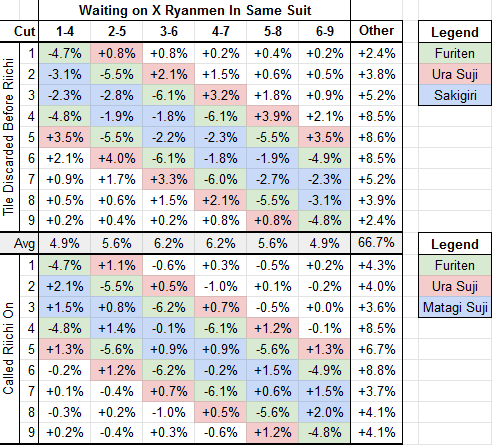I wasn't really happy with my previous analyses that included ura suji or matagi suji. The data was kind of noisy. So, this time, I'll be narrowing the search to make it clearer.
First, a reminded of what ura suji and matagi suji are. Ura suji arises from a kanchan upgrading to a ryanmen. For example, if you have 35m, and then draw the 6m for 356m, you would often cut the 3m. It's a better wait, and with a 56 nearby, the 3 is a much worse floating tile. If you draw a 4, it completes the 56, so the only tile you can draw to upgrade the floating 3 to a ryanmen is a 2. So, the floating 3 in 356 is lowered in strength to the level of a floating 2/8. The idea is that a 3 would therefore make the 47 more dangerous.
Matagi suji comes from shapes such as 334m. This shape is rather strong. It accepts 235m to complete a set, and plays a role in perfect iishanten (334m56p77s for example, tenpai on 235m47p7s, all with good wait) by providing another pair. You would not often break this shape early. There are two matagi shapes for 3: 334 and 233. The theory is that an early 3 therefore makes the 25 and 14 safer, because it would be sakigiri, a discard earlier than efficiency dictates. A late 3 however makes them more dangerous, since they could have reached tenpai and cut it to get the ryanmen wait.
Those are the ideas, anyway. These both deal with good waits, so for this analysis, I'm only looking at riichis that have a ryanmen wait. I checked their discards before riichi as well as the tile they riichi'd on, and counted how often they had each ryanmen at the end with that discard. First, let's look at the shapes each tile would be cut from to create each ryanmen.
With that in mind, let's look at how often they wait on each ryanmen with each discard.You can see the average percents in the center of the table, but it's a bit of a pain to compare. So, let's look at the multiplicative difference with the average. A percentage above 100% means it's more likely than average, while a percentage below 100% means that it's less likely than average.
Let's start by looking at the blue squares. When the tile comes before riichi, the matagi sujis are made safer, as the theory predicted. However, when it's the riichi tile, they are not made safer, and are generally just as dangerous as the other non-suji shapes. They're not particularly more dangerous, aside from the 1-4 and 6-9 matagis, they simply are not safe.
Now let's move onto the red squares. At first glance, it looks like ura suji is adding quite a lot of danger pre-riichi. But, all the other unaffected suji are also made more dangerous. The matagi is made safer because of sakigiri, some are made furiten, and so, the rest are inherently more dangerous. Though, the ura suji does get more dangerous, probably because the 3 is worse in a 356 than in a 367. In a 367, the 3 still has two tiles to upgrade to a ryanmen, so you're less incentivized to cut it.
As the riichi tile, everything outside of the furiten ryanmen are kind of similar. I imagine the danger from ura suji here is largely from people staying dama on a kanchan, upgrading, and calling riichi. The matagi suji could also be people dama on shanpon that then upgrades into a ryanmen, on top of the normal matagi theory.
Let's look at this chart colored by the relative danger.
Kind of interesting. We can also look at the absolute difference between the percents and the average.
In summary, ura suji and matagi suji do have an effect. Matagi suji is more important for the early discards though, where it creates sakigiri ryanmen. Ura suji can also be simplified down by realizing that with the furiten and sakigiri ryanmen made safer, all the other ryanmen become relatively more dangerous.
There's actually a third type of suji that shows up in these, but it's... not really a thing. It's called senki suji. While ura suji is the adjacent suji of the discard, the senki suji is two away. So, for a 1 discard, it'd be the 3-6. This comes from having a 14 shape and cutting the 1, then later drawing the 5 to form a ryanmen with the 4. Not really worth thinking about.
Next time, I might look at the last two discards from a suit before riichi. I said I was going to do a dama analysis, and I did, but I don't trust the results (do Houou players really dama 25% of ryanmens and 60% of single waits? Not sure.)





When you say "I'm only looking at riichis that have a ryanmen wait." does that mean that all that is being considered with these percentages is riichis with ryanmen waits? in other words, these relative percentages only apply to hands that are in riichi that also have a ryanmen wait and are not comparable against riichi generally?
ReplyDelete